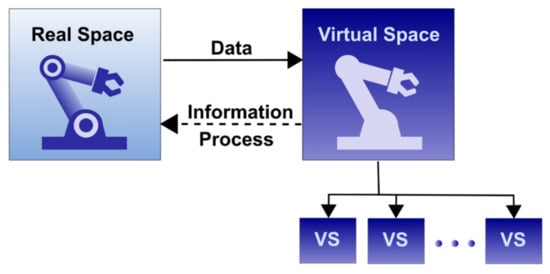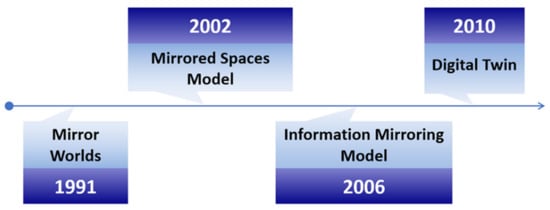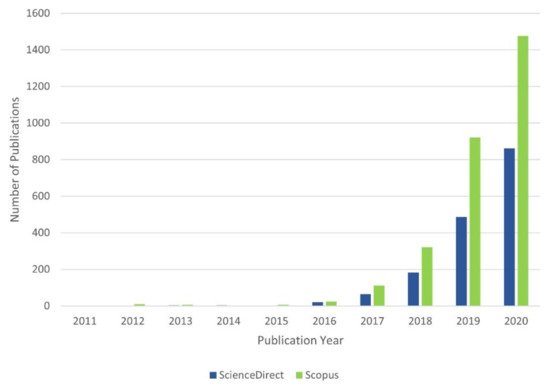
| Version | Summary | Created by | Modification | Content Size | Created at | Operation |
|---|---|---|---|---|---|---|
| 1 | Maulshree Singh | + 1419 word(s) | 1419 | 2021-06-02 11:26:25 | | | |
| 2 | Nora Tang | Meta information modification | 1419 | 2021-06-25 02:43:35 | | |
Video Upload Options
Digital Twin (DT) refers to the virtual copy or model of any physical entity (physical twin) both of which are interconnected via exchange of data in real time. Conceptually, a DT mimics the state of its physical twin in real time and vice versa. Application of DT includes real-time monitoring, designing/planning, optimization, maintenance, remote access, etc. Its implementation is expected to grow exponentially in the coming decades. The advent of Industry 4.0 has brought complex industrial systems that are more autonomous, smart, and highly interconnected. These systems generate considerable amounts of data useful for several applications such as improving performance, predictive maintenance, training, etc. A sudden influx in the number of publications related to ‘Digital Twin’ has led to confusion between different terminologies related to the digitalization of industries. Another problem that has arisen due to the growing popularity of DT is a lack of consensus on the description of DT as well as so many different types of DT, which adds to the confusion. This paper intends to consolidate the different types of DT and different definitions of DT throughout the literature for easy identification of DT from the rest of the complimentary terms such as ‘product avatar’, ‘digital thread’, ‘digital model’, and ‘digital shadow’. The paper looks at the concept of DT since its inception to its predicted future to realize the value it can bring to certain sectors. Understanding the characteristics and types of DT while weighing its pros and cons is essential for any researcher, business, or sector before investing in the technology.
1. Introduction
2. History of Digital Twin


3. Advantages, Characteristics and Types of Digital Twin

References
- Tao, F.; Zhang, M.; Nee, A.Y.C. Chapter 2—Applications of Digital Twin. In Digital Twin Driven Smart Manufacturing; Tao, F., Zhang, M., Nee, A.Y.C., Eds.; Academic Press: Cambridge, MA, USA, 2019; pp. 29–62.
- Kritzinger, W.; Karner, M.; Traar, G.; Henjes, J.; Sihn, W. Digital Twin in manufacturing: A categorical literature review and classification. IFAC-PapersOnLine 2018, 51, 1016–1022.
- Parrott, A.; Warshaw, L. Industry 4.0 and the Digital Twin: Manufacturing Meets its Match; Deloitte University Press: New York, NY, USA, 2017; pp. 1–17.
- Tao, F.; Zhang, M.; Nee, A.Y.C. Chapter 1—Background and Concept of Digital Twin. In Digital Twin Driven Smart Manufacturing; Tao, F., Zhang, M., Nee, A.Y.C., Eds.; Academic Press: Cambridge, MA, USA, 2019; pp. 3–28.
- MarketsandMarkets. Digital Twin Market by Technology, Type (Product, Process, and System), Application (Predictive Maintenance, and Others), Industry (Aerospace & Defense, Automotive & Transportation, Healthcare, and others), and Geography—Global Forecast to 2026; MarketsandMarkets: Pune, India, 2020; p. 177.
- Erol, T.; Mendi, A.F.; Doğan, D. Digital Transformation Revolution with Digital Twin Technology. In Proceedings of the 2020 4th International Symposium on Multidisciplinary Studies and Innovative Technologies (ISMSIT), Istanbul, Turkey, 22–24 October 2020; pp. 1–7.
- Negri, E.; Fumagalli, L.; Macchi, M. A review of the roles of digital twin in cps-based production systems. Procedia Manuf. 2017, 11, 939–948.
- Tao, F.; Zhang, H.; Liu, A.; Nee, A.Y. Digital twin in industry: State-of-the-art. IEEE Trans. Ind. Inform. 2018, 15, 2405–2415.
- Barricelli, B.R.; Casiraghi, E.; Fogli, D. A Survey on Digital Twin: Definitions, Characteristics, Applications, and Design Implications. IEEE Access 2019, 7, 167653–167671.
- Cimino, C.; Negri, E.; Fumagalli, L. Review of digital twin applications in manufacturing. Comput. Ind. 2019, 113, 103130.
- Liu, M.; Fang, S.; Dong, H.; Xu, C. Review of digital twin about concepts, technologies, and industrial applications. J. Manuf. Syst. 2020, 58, 346–361.
- Lu, Y.; Liu, C.; Kevin, I.; Wang, K.; Huang, H.; Xu, X. Digital Twin-driven smart manufacturing: Connotation, reference model, applications and research issues. Robot. Comput. Integr. Manuf. 2020, 61, 101837.
- He, B.; Bai, K.-J. Digital twin-based sustainable intelligent manufacturing: A review. Adv. Manuf. 2020, 9, 1–21.
- Magomadov, V. The digital twin technology and its role in manufacturing. In Proceedings of the IOP Conference Series: Materials Science and Engineering, Krasnoyarsk, Russia, 16–18 April 2020; p. 032080.
- Grieves, M. Origins of the Digital Twin Concept. 2016. Available online: (accessed on 25 September 2020).
- Grieves, M.W. Product lifecycle management: The new paradigm for enterprises. Int. J. Prod. Dev. 2005, 2, 71–84.
- Gelernter, D. Mirror Worlds: Or: The Day Software Puts the Universe in a Shoebox. How it Will Happen and What it Will Mean; Oxford University Press: Oxford, UK, 1993.
- Främling, K.; Holmström, J.; Ala-Risku, T.; Kärkkäinen, M. Product agents for handling information about physical objects. Rep. Lab. Inf. Process. Sci. Ser. B TKO-B 2003, 153.
- Grieves, M. Back to the future: Product lifecycle management and the virtualization of product information. In Product Realization; Springer: Boston, MA, USA, 2009; pp. 1–13.
- Shafto, M.; Conroy, M.; Doyle, R.; Glaessgen, E.; Kemp, C.; LeMoigne, J.; Wang, L. Draft modeling, simulation, information technology & processing roadmap. Technol. Area 2010, 11.
- Rosen, R.; Von Wichert, G.; Lo, G.; Bettenhausen, K.D. About the importance of autonomy and digital twins for the future of manufacturing. IFAC-PapersOnLine 2015, 48, 567–572.
- Boschert, S.; Rosen, R. Digital twin—The simulation aspect. In Mechatronic Futures; Springer: Cham, Switzerland, 2016; pp. 59–74.
- Tuegel, E. The airframe digital twin: Some challenges to realization. In Proceedings of the 53rd AIAA/ASME/ASCE/AHS/ASC Structures, Structural Dynamics and Materials Conference 20th AIAA/ASME/AHS Adaptive Structures Conference 14th AIAA, Honolulu, HI, USA, 23–26 July 2012; p. 1812.
- Tuegel, E.J.; Ingraffea, A.R.; Eason, T.G.; Spottswood, S.M. Reengineering aircraft structural life prediction using a digital twin. Int. J. Aerosp. Eng. 2011, 2011.
- Gockel, B.T.; Tudor, A.H.; Brandyberry, M.D.; Penmetsa, R.C.; Tuegel, E.J. Challenges with Structural Life Forecasting Using Realistic Mission Profiles. In Proceedings of the 53rd AIAA/ASME/ASCE/AHS/ASC Structures, Structural Dynamics and Materials Conference, Honolulu, HI, USA, 23–26 July 2012; p. 1813.
- Glaessgen, E.; Stargel, D. The digital twin paradigm for future NASA and US Air Force vehicles. In Proceedings of the 53rd AIAA/ASME/ASCE/AHS/ASC Structures, Structural Dynamics and Materials Conference, Honolulu, HI, USA, 23–26 July 2012; p. 1818.
- Gartner Identifies the Top 10 Strategic Technology Trends for 2017. Available online: (accessed on 12 October 2020).
- Gartner Identifies the Top 10 Strategic Technology Trends for 2018. Available online: (accessed on 12 October 2020).
- Gartner Identifies the Top 10 Strategic Technology Trends for 2019. Available online: (accessed on 12 October 2020).
- Qi, Q.; Tao, F.; Zuo, Y.; Zhao, D. Digital twin service towards smart manufacturing. Procedia Cirp. 2018, 72, 237–242.
- Marr, B. These 25 Technology Trends Will Define the Next Decade. Available online: (accessed on 12 October 2020).
- D’mello, A. Spend on Digital Twins to Reach $12.7bn by 2021, as Solutions Offer IoT Investment RoI. 2020. Available online: (accessed on 12 October 2020).
- Digital Twin: Market Estimates & Trend Analysis To 2025; Grand View Research: San Francisco, CA, USA, 2018; p. 80.




